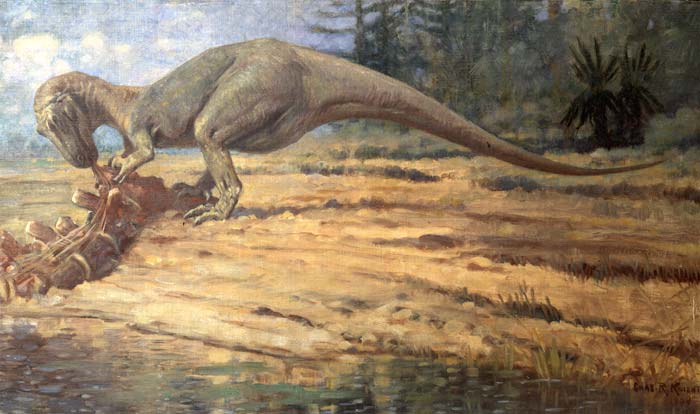But what about dinosaurs? Were they more reptilian, like the creatures they evolved from? Or were they more like their later descendants, the birds of today? This debate has been going on in the paleontology community for decades. A new study points towards the "warm-blooded" model, and the implications help change how we think of dinosaurs.
Obviously, today, we can watch animal behavior to determine if a creature is ectothermic or endothermic. We can also use morphology. Endothermic animals use more energy to move around than ectothermic creatures. The length of an organism's legs is directly related to this energy usage. Fossils give us this information beautifully. Thus, in the study, the hip heights of various dinosaur species were measured. The scientists also used some musculature reconstructions to help approximate the energy each creature would have used to walk. The results? Most, if not all, dinosaurs were most likely warm-blooded. In fact, this trait might have developed in the earliest dinosaurs, making it older than previously thought. It certainly presents a different view of the Mesozoic world.
The Cold-Blooded View
Take a trip back to the Jurassic. You end up in a fern-meadow, with a few trees scattered about. It's a cool morning, but the day will be warm. A herd of Diplodocus are lying in the sun, warming up. A lone Allosaurus is around near some trees. It is tearing hunks off of a dead juvenile Diplodocus. Based on the insects and decay, it's been dead for a while. While the carnivore looks impressive, it lumbers slowly, and is probably not intelligent enough to take down a even a juvenile. One of the more intelligent dinosaurs would have been little Compsognathus, which was only the size of a chicken. As you watch, it catches a dragonfly.
The Warm-Blooded View
 Through the benefits of imagination, the scene blurs and changes. You're still in the same fern-meadow, on the same day. The behavior of the dinosaurs has changed radically, however. You find yourself between two very different hunts. The Compsognathus has climbed up onto a tree stump, and is intently watching a hole in the ground. A small lizard darts out. Before it gets more than a foot, however, the Compsognathus pounces on it, grabbing it in long-fingered hands. The lizards struggles feebly, before the dinosaur decapitates it.
Through the benefits of imagination, the scene blurs and changes. You're still in the same fern-meadow, on the same day. The behavior of the dinosaurs has changed radically, however. You find yourself between two very different hunts. The Compsognathus has climbed up onto a tree stump, and is intently watching a hole in the ground. A small lizard darts out. Before it gets more than a foot, however, the Compsognathus pounces on it, grabbing it in long-fingered hands. The lizards struggles feebly, before the dinosaur decapitates it.Meanwhile, the Diplodocus herd has been walking through the meadow, whip-like tails drawing patterns in the air. A young one is limping near the outside of the herd. The Allosaurus is standing motionless in the shadow of a tree, watching it. Suddenly, it stumbles, and the creature springs to life. It springs out, along with two other Allosaurs, quickly biting on the the Diplodocus. One bites its neck, while another tears a chunk out of the already injured leg. The third guards, snapping at an adult to distract the herd from the little one. In a matter of minutes, the ambush is over. The juvenile is motionless, and the two Allosaurs are dragging it away, while the third retreats and rejoins the pack. The Diplodocus herd lets out some bellows, and reconfigures. All the young ones are now concentrated in the center, protected by adults. They will not be caught off-guard again.
As you can see, the warm-blooded idea of dinosaurs makes them far more intelligent (and possibly more interesting) creatures. It's been a controversial idea since it was first proposed by Robert Bakker in the early 1970's, however, and the debate is still going on today. It is evidence like this study which allows us to finally solve this question.








